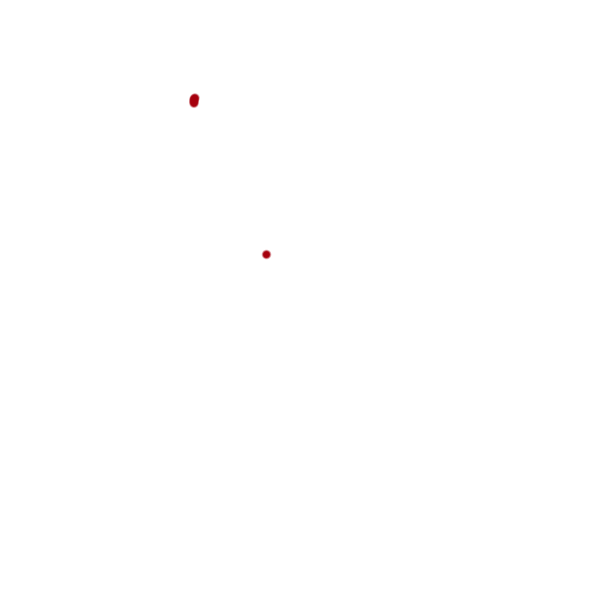DIGITAL DOMAIN ALWAYS KNEW IT WAS AGATHA ALL ALONG
Février 4, 2025
Featured in VFX Voice
Images courtesy of Digital Domain and Disney+.
WandaVision spin-off Agatha Harkness, the main antagonist in the Disney+ miniseries Agatha All Along, must travel the Witches’ Road to regain her powers. Created by Jac Schaeffer, the dark supernatural fantasy has been digitally enhanced by Production Visual Effects Supervisor Kelly Port and main vendor Digital Domain, which was responsible for magic effects for the Broom Chase and Agatha’s death and ghost. The visual effects work had to feel as real as possible, which meant keeping things grounded and limiting the amount of fantastical CG, like camera moves that could not be achieved in real life.


“That was a consistent directive throughout the entire show,” states Michael Melchiorre, Visual Effects Supervisor at Digital Domain. “What production tried to do on set is to shoot as much of it practically. When they’re walking down the road through multiple episodes, that was an enormous set build in a warehouse, and a lot of those shots were subtle extensions in the background.” Witches’ Road was treated as a member of the cast with attention to detail ranging from the density of the leaves, the shape and height of trees, and the curvature of the road. “There is one way through, and you can only go forward. We would use our digital forest to fill in anywhere it felt like, ‘Maybe you could have turned off that way.’” The environment was built to withstand any possible camera angle. “There were a couple of shots where we opted for our full CG road, and they were indistinguishable from the plate versions. You could go right down to the ground level if you wanted to.”

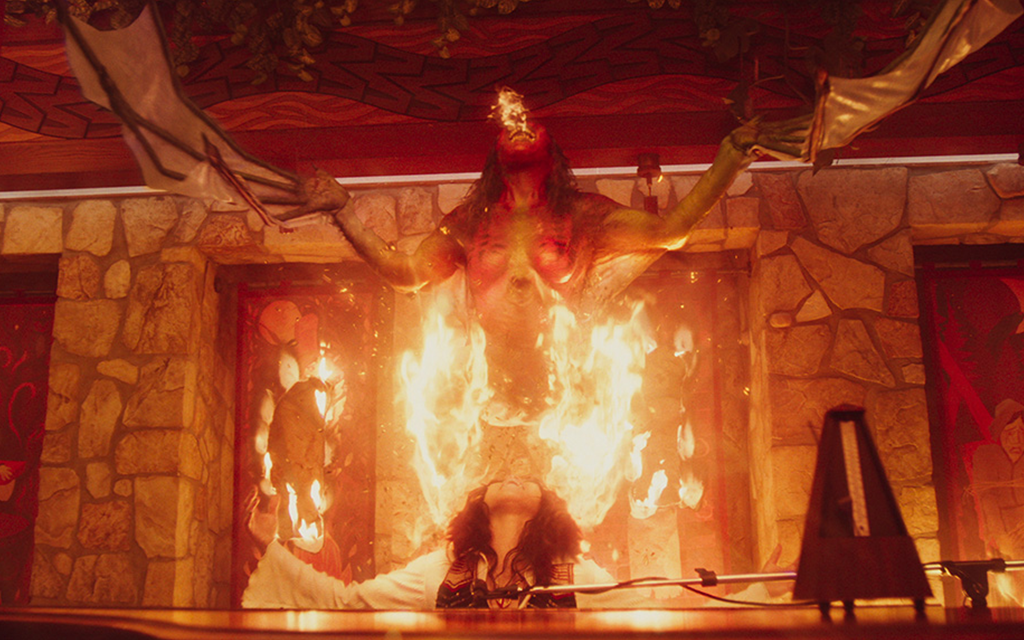
Despite the massive size of the Witches’ Road set, it was still not long enough for the Broom Chase. “You had a road that would go straight, turn left and come around in a circle,” Melchiorre explains. “The Broom Chase was filmed by drones going down each straightaway. At the same time, the set pieces could be rearranged. There were trees on wheels that would be rolled in, and they would run the drone down again. You get these subtle variations. So many of the trees are gnarled and distinct that if you rotated them a little bit, it almost gave you completely different-looking trees because there weren’t straight trunks. The problem with the Broom Chase was that we were supposed to be cruising through this forest, and the drone only has so much runway before it has to make a turn. The road was always straight ahead, meaning they weren’t making hard lefts or rights on their brooms. There was an array setup on a drone of three 8K cameras giving us coverage dead ahead and off to the left and right. We could then stitch that back together to give ourselves a large canvas to work with as to what we are going to see when we’re coming down the road. For the speed of the Broom Chase, you lose real estate fast. Once you rephotographed those large 8K tiles with the camera that matches with the corresponding lens, you gain a little bit more real estate, but that’s where we also built our fully digital recreation of the road that was used to extend and enhance.”
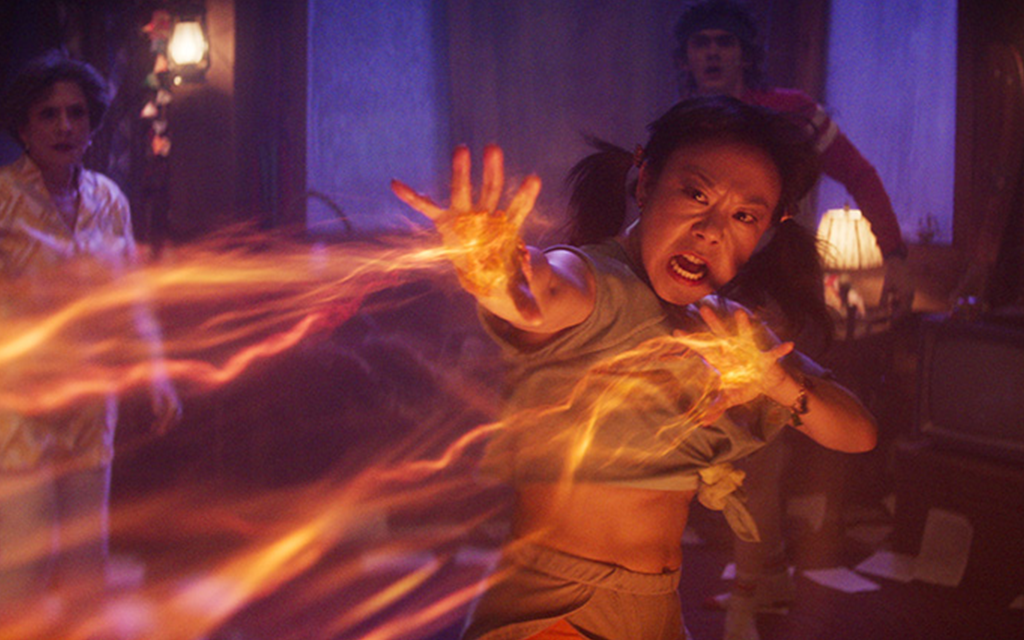
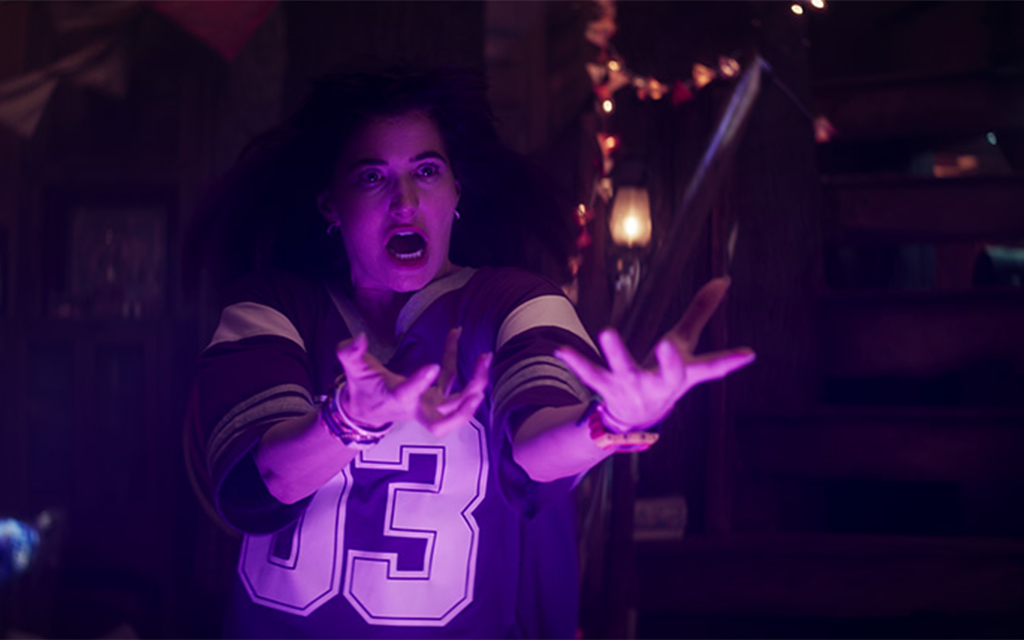
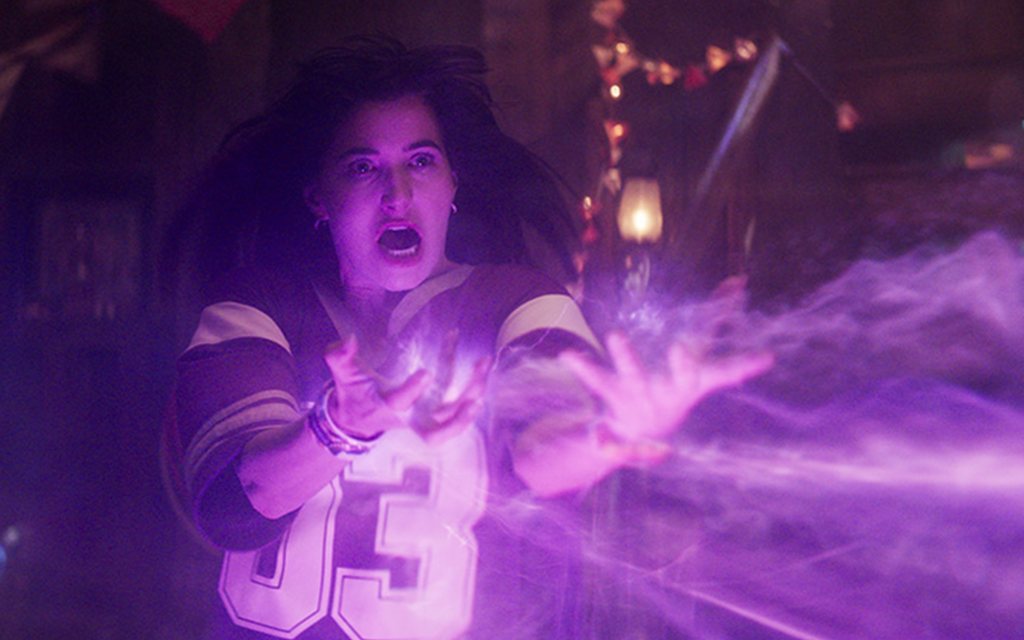
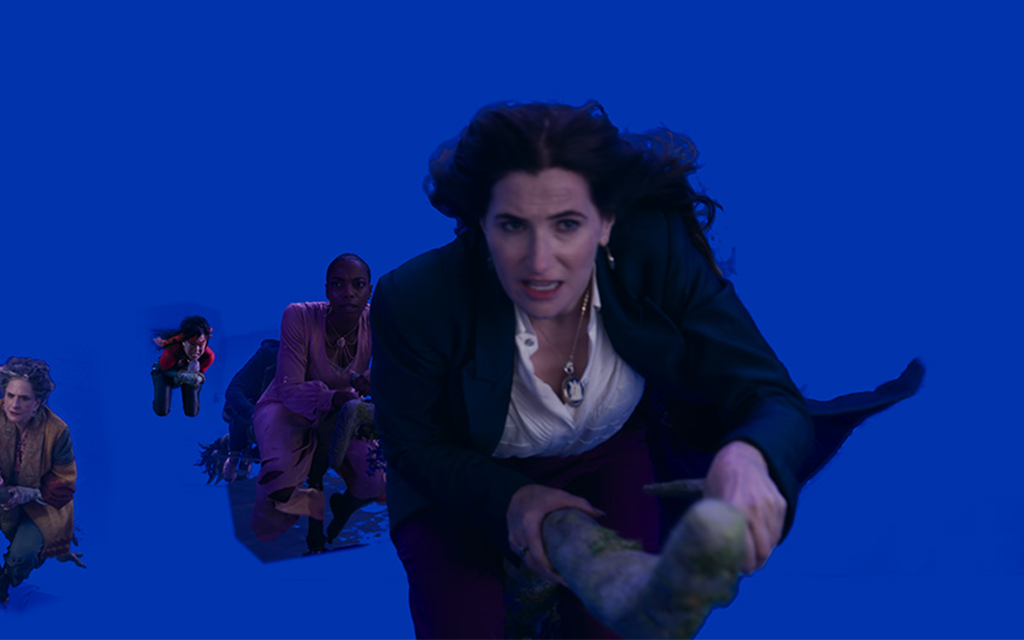
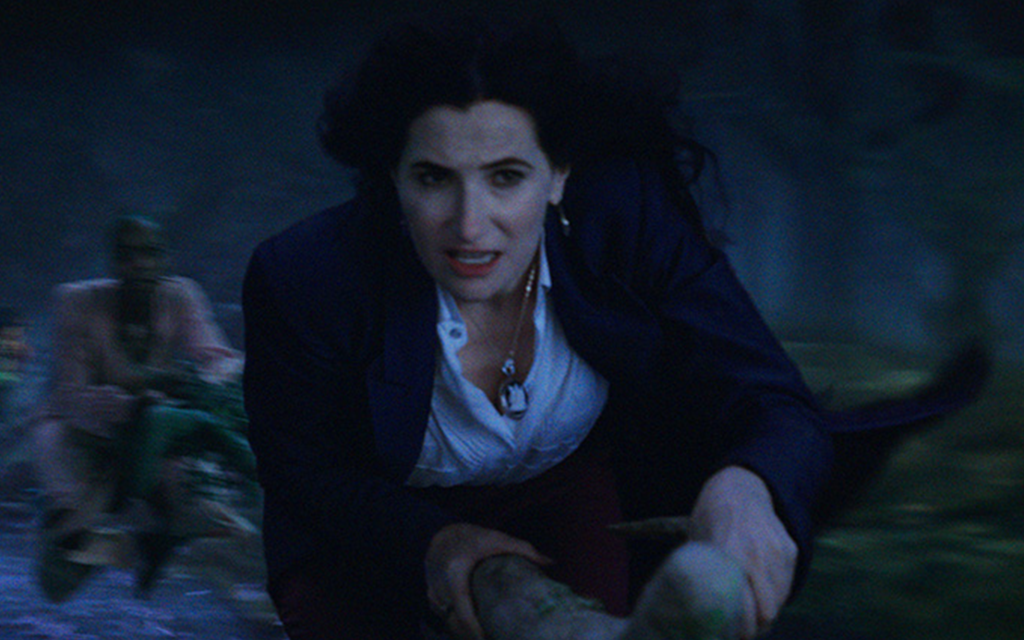
Witches on flying brooms are a staple of the fantasy genre. “On set, there was a small saddle that was covered by the costumes for the most part,” Melchiorre explains. “We had some cases where it had to be painted out. Extensive previs was done to try to figure out what the sequence needed to look like, so there was an intent to shoot the plates to approximate that as much as possible. It worked out in a lot of cases, but for other ones, afterwards we went, ‘This camera angle would be better.’ Once we had our plates and backgrounds sorted, knowing what this shot is going to be down the road, that’s when we went to our animation team. We had the animators use our recreation of the forest to match what the chosen array footage was doing. Each member of the Coven was shot on a bluescreen hanging by a harness, acting and weaving as they were flying their broom. Compositing quickly extracted all of those characters to give the animators something to work with. The animators then took those and moved them down through our CG forest and matched the orientation of the plates we were using. That helped us keep our scale, position and depth of all the Coven members consistent between themselves and the forest trees. Otherwise, we could run into issues where their depth is based on what we’re seeing in screen space.”

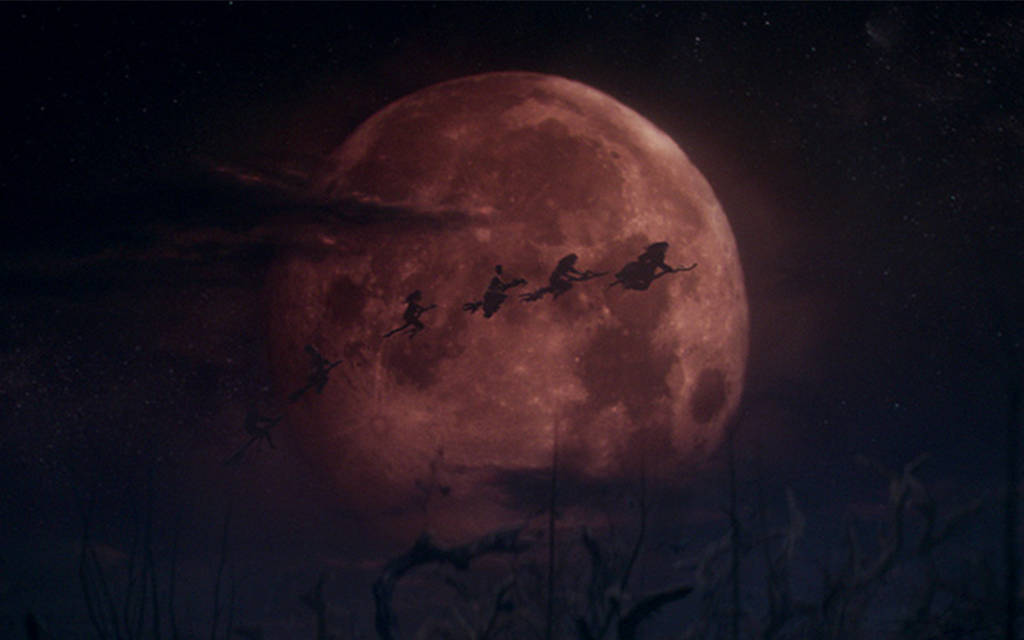
Tesla coils, lightning and WandaVision were points of reference for the magic effects. “The magic was a big compositing development item,” Melchiorre states. “There was a scene in WandaVision where Agatha uses her powers to suck the life out of other witches, so we know what these things look like. The challenge was to replicate that and have six different versions of it, plus there is a gaggle of generic witches we see Agatha suck the power out of over the years. They were all various colors and strengths and had to be slightly different. On WandaVision, when we did Agatha’s powers, the effects team ran multiple simulations. For this show, it was calling back to the Ghostbusters beams or the Emperor’s lightning from Star Wars: Episode VI – Return of the Jedi. We wanted to lean on those techniques, so all the magic that we see in Agatha All Along was created in Nuke with a combination of particle generation, Tesla coil and lightning elements, using the Higx Point Render plug-in in Nuke to produce noise patterns that we could then rotate around to some extent and get perspective on. There were instances where we wanted a bolt of energy to hit one finger [then transfer] to another. Compositors went in and literally drew lightning energy going from one finger to another.”
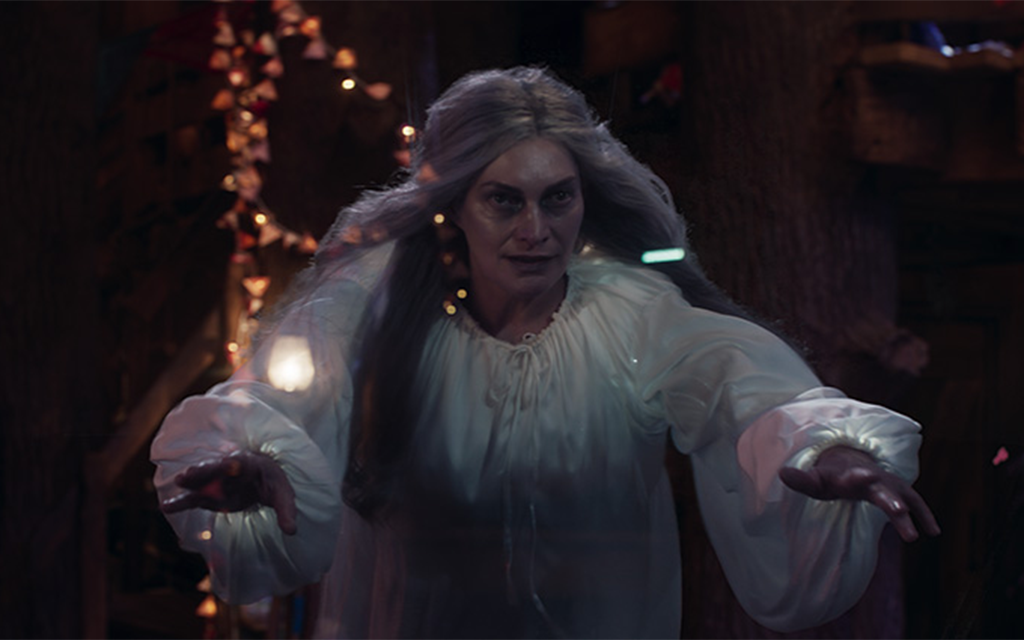
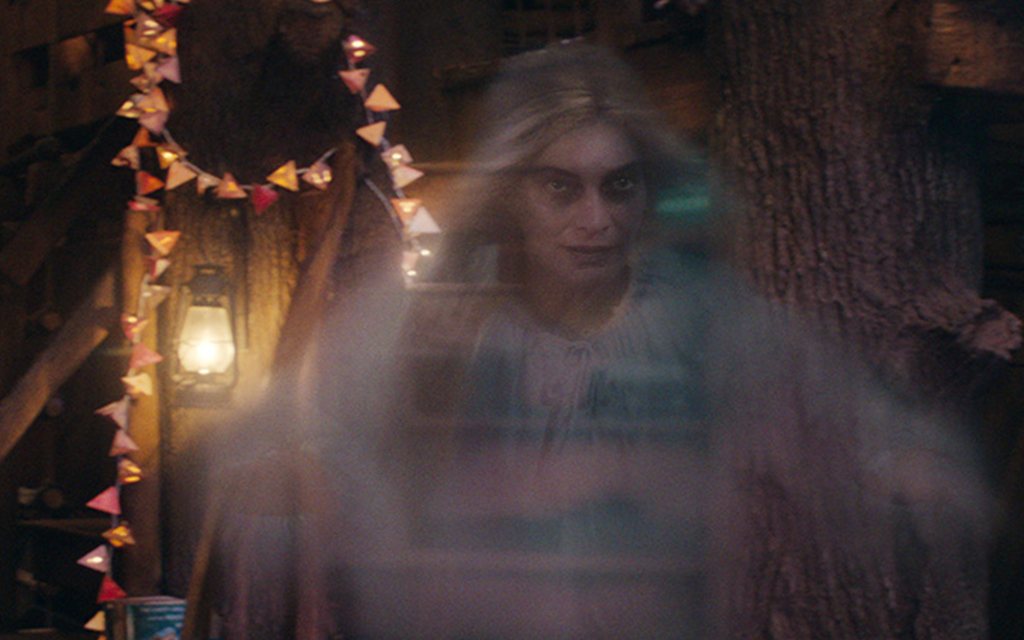
During the climax of the series, Teen gives his powers to Agatha. “Agatha’s powers grow out from her like tentacles, and as it grabs Teen’s powers, it would alter his blue to her purple,” Melchiorre remarks. “When we did that, it would reverse the direction of the beam and suck back towards her. There were some interactive shots, but not for the most part. There was lots of elbow grease and compositing to relight parts of the plate and light up the hands and face, as best we could, to help tie to the proximity of the magic going by or hitting them. You’ll see a number of shots where Agatha is being fired upon with lots of beams hitting her shoulders or torso. We always made sure that the intensity of the beam and contact point were in sync with each other. If a bright piece of beam came in, the piece that hit her would always be bright and dissipate out as a darker piece of beam that came behind it. Many of those were almost frame-by-frame dialing up to make sure that contact was tight. Much of it was achieved with interactive light on the character being hit. We did a little bit of distortion around the contact points to give a subtle movement to it. But as far as cloth simulations or replacing cloth, that wasn’t one of the driving forces behind this. We wanted to keep it as tied to the plates as possible.”
The spectrum of magic colors included purple for Agatha, blue for Teen, green for Rio Vidal, orange for Alice Wu-Gulliver, yellow for Lilia Calderu and pink for Jennifer Kale. “Purple was fun to do because it charges up the most and gets the wildest,” Melchiorre notes. “Most of Agatha’s stuff was done at night, so the purple popped against the night sky. When she was taking in all the power from Teen, her stuff goes well beyond anybody else’s. Agatha is the character everyone loves to hate. Yellow was the toughest to get to show and feel hot, lit and bright in Lilia Calderu’s environment, which was more daylit; we only had a few shots of her magic.” Each of the colors has a bright white core. “The white core helps give the magic a heat and brightness that make it feel more like light instead of an oversaturated solid color.”

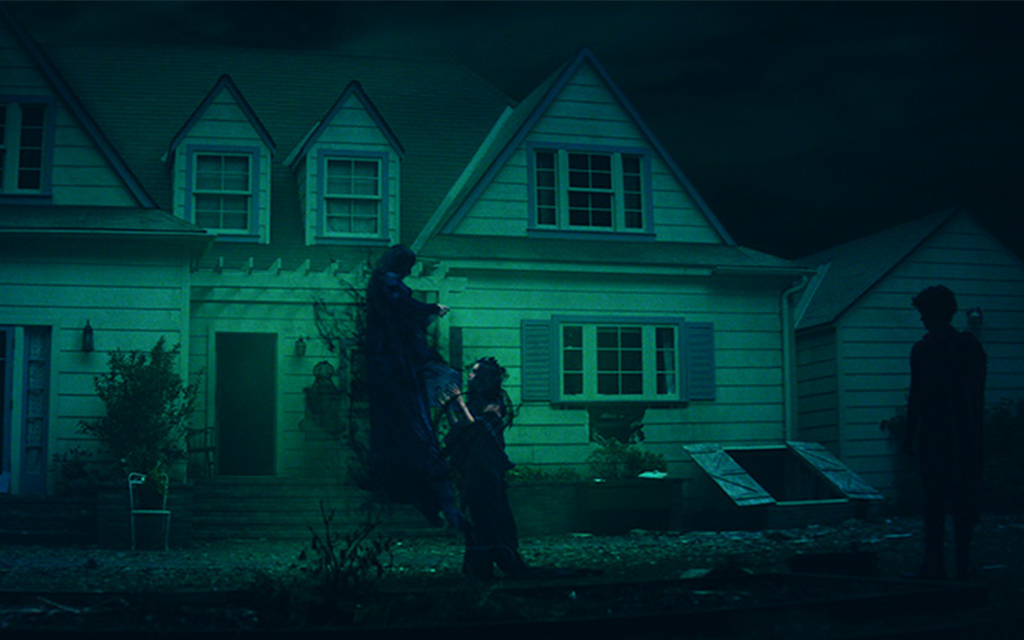
Desiccation occurs to the recipient of the power sucking. “This was tying back to WandaVision where Agatha does it to the Coven and Wanda,” Melchiorre remarks. “When she is sucking their powers, the victim’s face and skin dry out, sucks in, wrinkles and desiccates. On this show, we had a couple of hero ones, like when Agatha dies and Teen gets his powers drained from him. But we also had a Witches Through Time sequence toward the end of the series where we see how Agatha has been spending her time over the last hundreds of years conning other witches to unknowingly give away their powers. That meant another six or eight witches who needed to be desiccated. Back on WandaVision, it was one or two hero characters with a full 3D head rebuild that could be desiccated and animated. We did that same path for Agatha and Teen. There were full hero replicas of their heads that could be desiccated and animated and be shrunken and wrinkled as they lost their powers.”

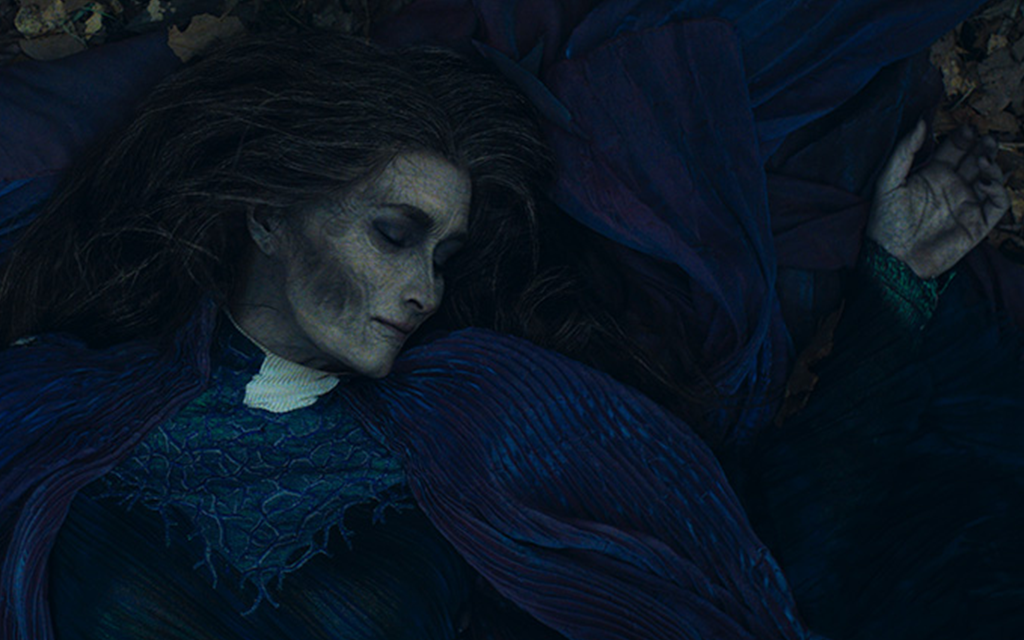
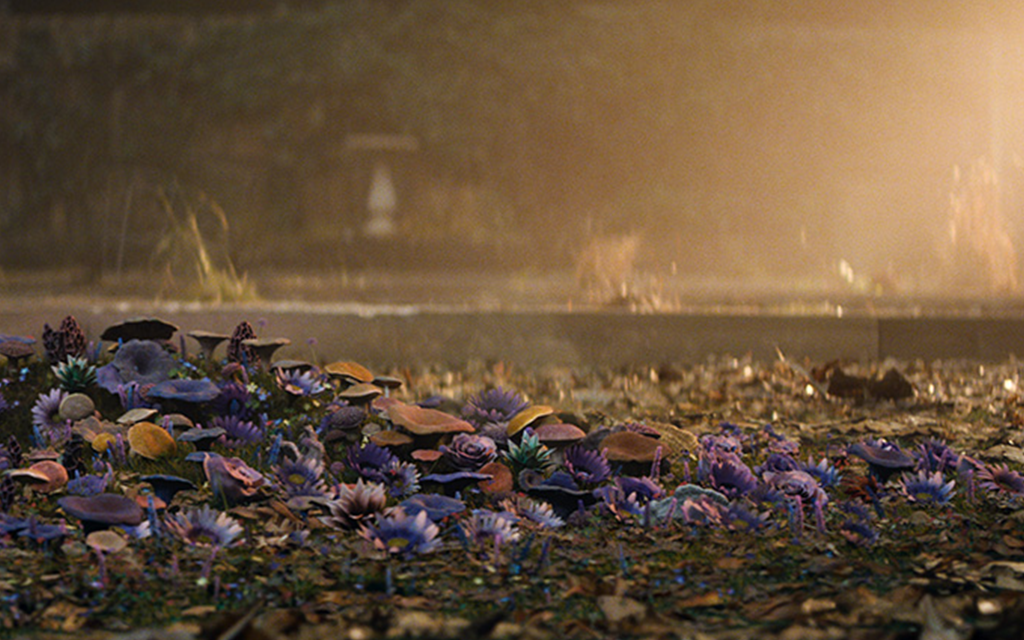
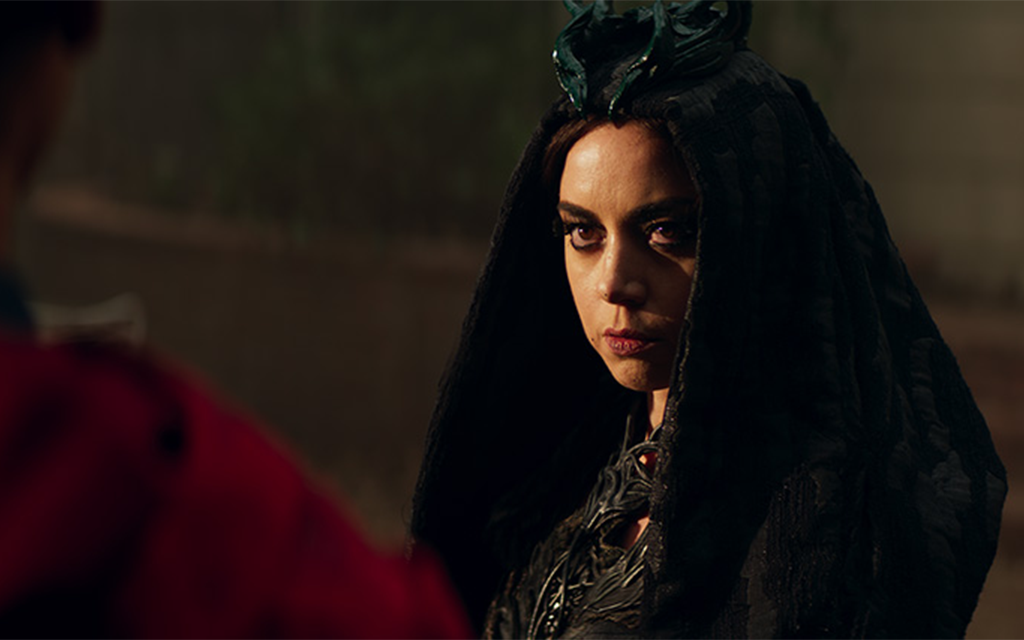
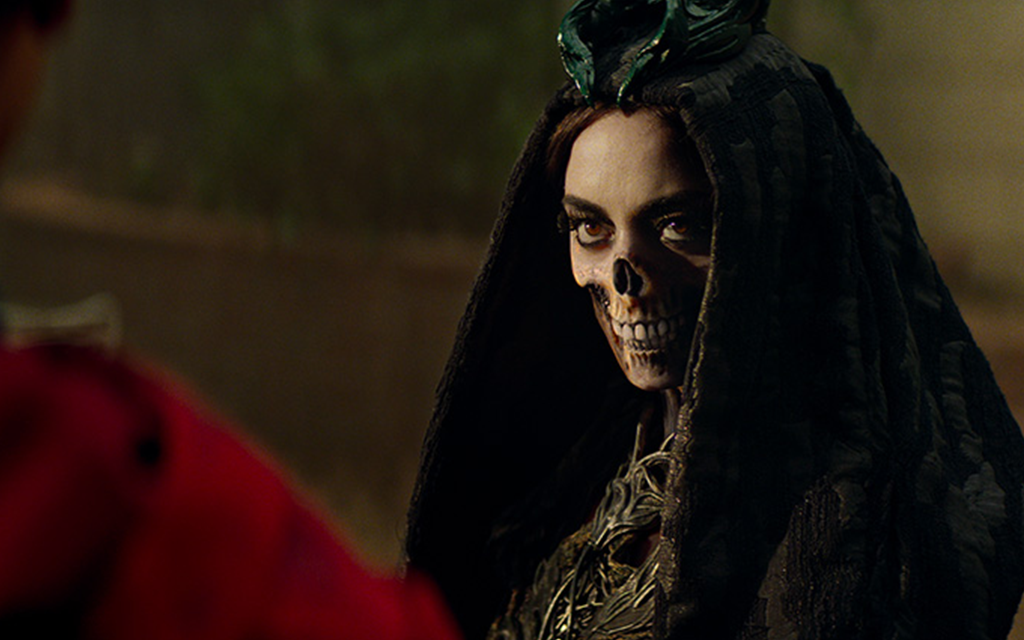

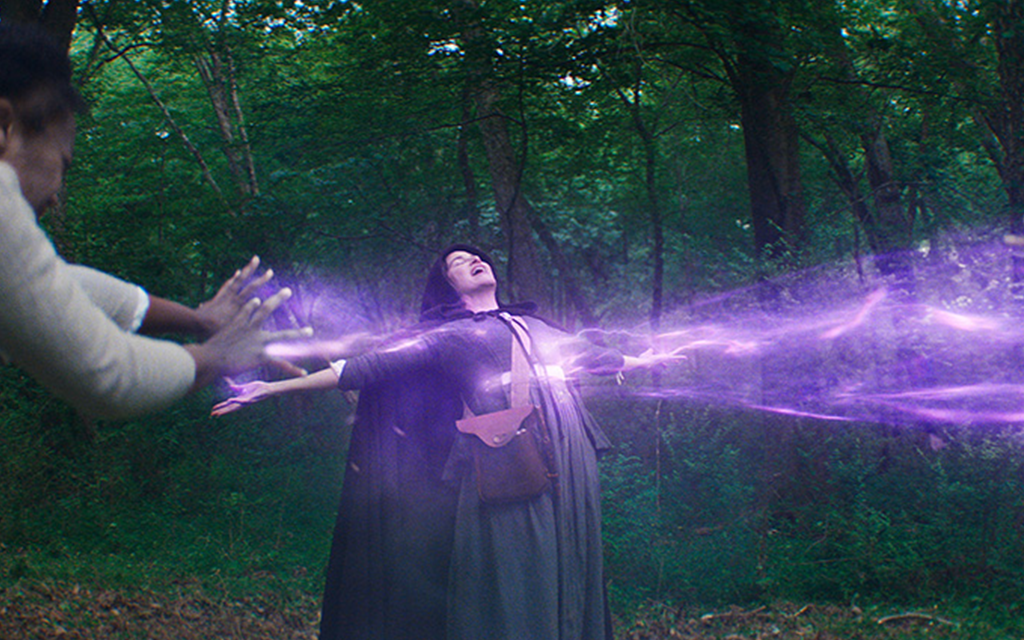

Agatha sacrifices herself to save Teen. “Agatha uses her powers to suck in and take the power from Rio, who we find out is Death,” Melchiorre explains. “We wanted this sequence of death and rebirth to happen over two or three shots where Agatha hits the ground, and as she lays on the ground her body starts to rapidly decay and break apart. But at the same time, the grass, flowers and mushrooms of the backyard start to grow and cover her. The mushrooms also die, and from there we have a rebirth of her purple flowers to signify her rebirth as a ghost. What we were aiming for was the image of a nurse log in the forest, a decaying log with mushrooms and moss growing on it, but at the same time it’s beautiful to look at. There was talk early on about how we could do that in 2D. Luckily, that was abandoned quickly. The burial mound is a full CG simulation down to single blades of grass, little pebbles and dirt falling off. Our artists had control over the speed and size of every mushroom that comes up and dies.”
In the end, staffing was the major challenge. “The biggest thing that we had to focus on were artists, especially the compositors,” Melchiorre states. “Coming from a compositing background, knowing the production’s goal, which was to try to use several techniques and methodologies from 30 to 40 years ago, it was ‘how can we stack our team with people who can do that?’Nothing against younger compositors now, but they have never had to use practical elements and make something out of nothing, to some extent. There is a lot of per-shot work that needs to be done to make these elements work like the magic. It was all set up in Nuke, but each individual artist had to marry the elements in a way that is a bit different from getting another simulation from effects.”
